

Anti-obesity therapy with peripheral CB1 blockers: from promise to safe(?) practice. Central fatness and risk of all cause mortality: systematic review and dose-response meta-analysis of 72 prospective cohort studies. Abstract Objective To quantify the association of indices of central obesity, including waist circumference, hip circumference, thigh circumference, waist-to-hip ratio, waist-to-height ratio, waist-to-thigh ratio, body adiposity index, and A body shape index, with the risk of all cause mortality in the general population, and to clarify the shape of the dose-response relations.
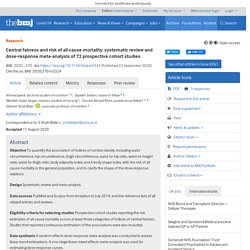
Design Systematic review and meta-analysis. Data sources PubMed and Scopus from inception to July 2019, and the reference lists of all related articles and reviews. Eligibility criteria for selecting studies Prospective cohort studies reporting the risk estimates of all cause mortality across at least three categories of indices of central fatness. Studies that reported continuous estimation of the associations were also included. Data synthesis A random effects dose-response meta-analysis was conducted to assess linear trend estimations. Introduction Methods Search strategy. Revisiting the Compensatory Theory as an explanatory model for relapse in obesity management. Skip to Main Content Advertisement Search Close Advanced Search Search Menu Article Navigation Article Contents Revisiting the Compensatory Theory as an explanatory model for relapse in obesity management.

Potential therapeutic applications of the gut microbiome in obesity: from brain function to body detoxification. The global burden of disease attributable to high body mass index in 195 countries and territories, 1990–2017: An analysis of the Global Burden of Disease Study. Abstract Background Obesity represents an urgent problem that needs to be properly addressed, especially among children.
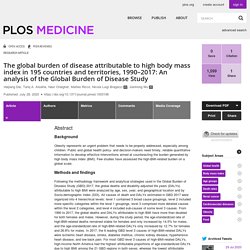
Public and global health policy- and decision-makers need timely, reliable quantitative information to develop effective interventions aimed at counteracting the burden generated by high body mass index (BMI). Few studies have assessed the high-BMI-related burden on a global scale. Safety and side effects of apple vinegar intake and its effect on metabolic parameters and body weight: a systematic review. What words should we use to talk about weight? A systematic review of quantitative and qualitative studies examining preferences for weight‐related terminology - Puhl - 2020 - Obesity Reviews.
Evidence of weight stigma and its harmful consequences have led to increased attention to the words that are used to talk about obesity and body weight, including calls for efforts to carefully consider weight‐related terminology and promote respectful language in the obesity and medical fields.
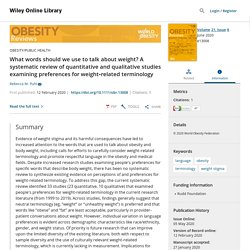
Despite increased research studies examining people's preferences for specific words that describe body weight, there has been no systematic review to synthesize existing evidence on perceptions of and preferences for weight‐related terminology. To address this gap, the current systematic review identified 33 studies (23 quantitative, 10 qualitative) that examined people's preferences for weight‐related terminology in the current research literature (from 1999 to 2019).
Dietary Recommendations for Bariatric Patients to Prevent Kidney Stone Formation. Calcium absorption predominantly occurs in the duodenum and proximal jejunum and is dependent on vitamin D levels.
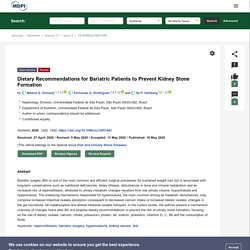
Due to fat malabsorption, all fat-soluble vitamins (A, D, E and K) are at risk of deficiency among bariatric patients. Some investigators pointed out a deficient calcium intake and vitamin D deficiency after RYGB [60]. Schafer et al. [61] demonstrated that even patients with acceptable levels of vitamin D (≥ 30 ng/mL) and maintained under an adequate calcium intake (> 1200 mg/day) had a marked decrease in intestinal calcium absorption from 33% preoperatively to 7% after 6 months of RYGB. The common use of proton-pump inhibitors by bariatric patients may also affect calcium absorption contributing to the exacerbation of such deficiency [62]. Clinical studies have also identified hypovitaminosis D in morbidly obese patients prior to RYGB [63,64]. Calcium absorption predominantly occurs in the duodenum and proximal jejunum and is dependent on vitamin D levels.
Effects and mechanisms of edible and medicinal plants on obesity: an updated review: Critical Reviews in Food Science and Nutrition: Vol 0, No 0. In recent years, obesity has become a global public health issue.
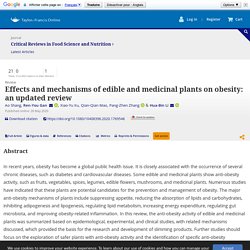
It is closely associated with the occurrence of several chronic diseases, such as diabetes and cardiovascular diseases. Does COVID‐19 Disprove the Obesity Paradox in ARDS? - Jose - - Obesity. Health, pleasure, and fullness: changing mindset affects brain responses and portion size selection in adults with overweight and obesity. European Society of Endocrinology Clinical Practice Guideline: Endocrine work-up in obesity in: European Journal of Endocrinology Volume 182 Issue 1 (2020)
Joint international consensus statement for ending stigma of obesity. Prevalence of weight bias, stigma, and discrimination Substantial research has demonstrated that weight stigma and discrimination are pervasive, global issues7,8.
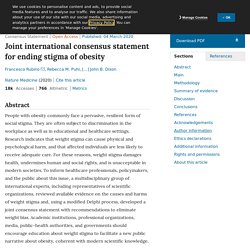
Weight stigma has been documented in multiple societal domains, including the workplace, education, healthcare settings, and within families9,10. Stigma has persisted despite the markedly increased prevalence of obesity in recent decades. Sharing the ‘weight’ of obesity management in primary care: integration of registered dietitian nutritionists to provide intensive behavioural therapy for obesity for Medicare patients.
We use cookies to enhance your experience on our website.By continuing to use our website, you are agreeing to our use of cookies.

You can change your cookie settings at any time. <a href=" Find out more</a> Skip to Main Content Search. Effectiveness of herbal medicines for weight loss: A systematic review and meta‐analysis of randomized controlled trials - Maunder - - Diabetes, Obesity and Metabolism. Overweight and obesity has reached epidemic proportions worldwide, with the global prevalence doubling since 1980.1 Obesity affects almost every aspect of health and is strongly associated with type 2 diabetes, cardiovascular disease and various cancers.2-4 Lifestyle interventions, including increasing physical activity and decreasing energy intake, are key components for treating obesity; however, results do not consistently show lifestyle modifications alone as promoting sufficient and sustained weight loss.5, 6 Conforming to a new regimen is problematic for many, and after the initial weight loss, weight regain is common.7 People unable to reduce weight satisfactorily with lifestyle interventions may be candidates for pharmacotherapy as an adjunct.
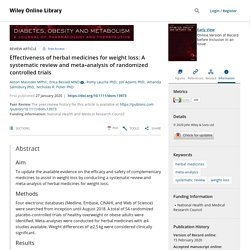
Despite the many supplements available, few have scientific support for their safety and efficacy. Unlike pharmaceutical drugs that require approval before being marketed, clinical evidence is not required for supplements. The Obesity Pandemic—Whose Responsibility? No Blame, No Shame, Not More of the Same. “Imprisoned in every fat man, a thin man is wildly signaling to be let out”

Waist circumference as a vital sign in clinical practice: a Consensus Statement from the IAS and ICCR Working Group on Visceral Obesity. Weight History in Clinical Practice: The State of the Science and Future Directions - Kushner - 2020 - Obesity. Introduction. The Local Food Environment and Obesity: Evidence from Three Cities - Walker - 2020 - Obesity. Study Importance What is already known? There are inconsistent findings on the association between features of the food environment and obesity. Previous studies have investigated features of the food environment in isolation.
There is also limited knowledge on the role of other features of the food environment such as bars/pubs and liquor stores. Scientific evidence of diets for weight loss: Different macronutrient composition, intermittent fasting, and popular diets. World Health Organization. Obesity. Available at: [Accessed 20 March 2019]. S.B. Wyatt, K.P. Winters, P.M. Am J Med Sci, 331 (2006), pp. 166-174 M.D. J Am Coll Cardiol, 63 (2014), pp. 2985-3023 H.A. J Acad Nutr Diet, 116 (2016), pp. 129-147 A. Ann N Y Acad Sci, 1411 (2018), pp. 106-119 C.W. le Roux, H.M.
Med Clin North Am, 102 (2018), pp. 165-182 D.S. Effects of Intermittent Fasting on Health, Aging, and Disease. European Society of Endocrinology Clinical Practice Guideline: Endocrine work-up in obesity in: European Journal of Endocrinology Volume 182 Issue 1 (2020)